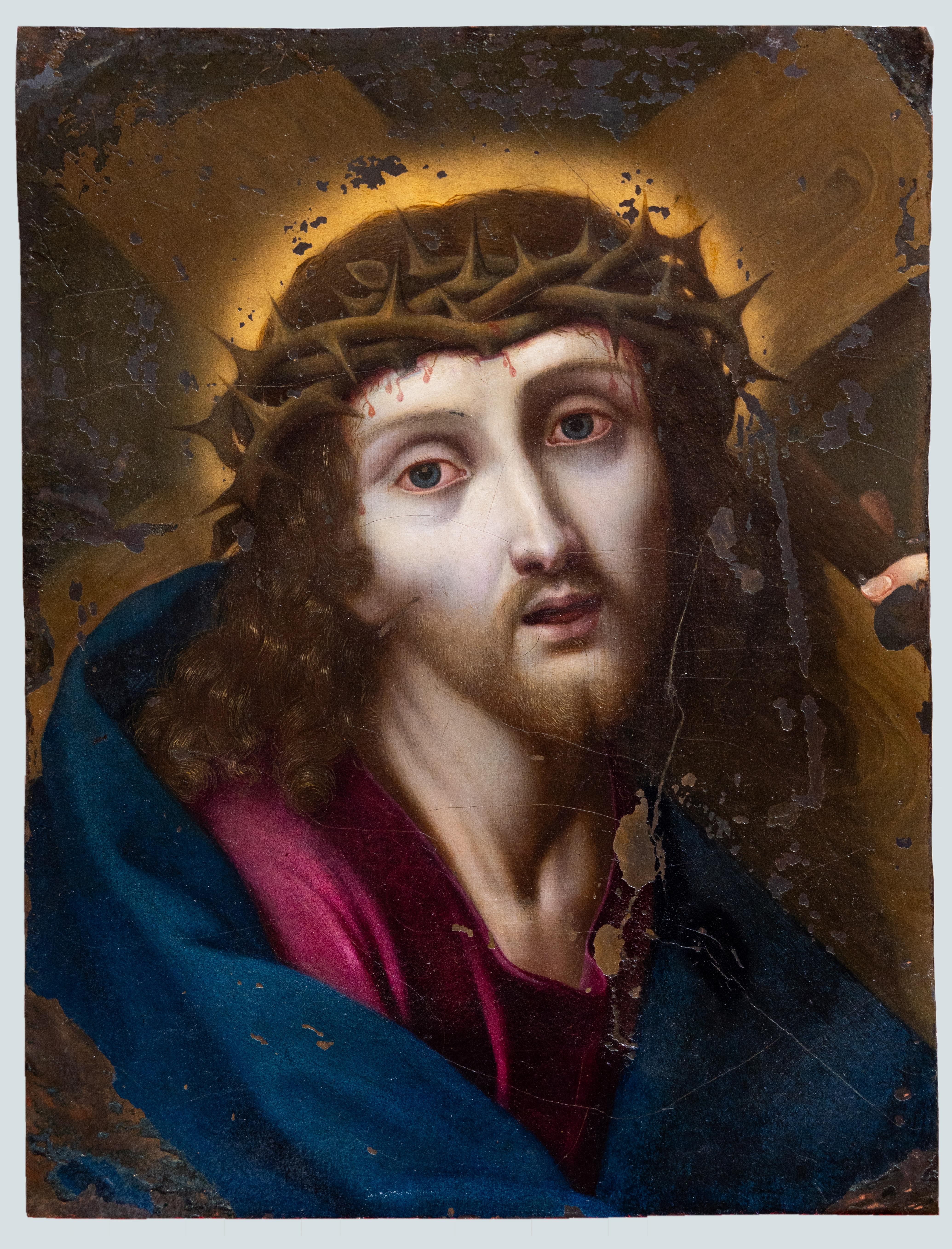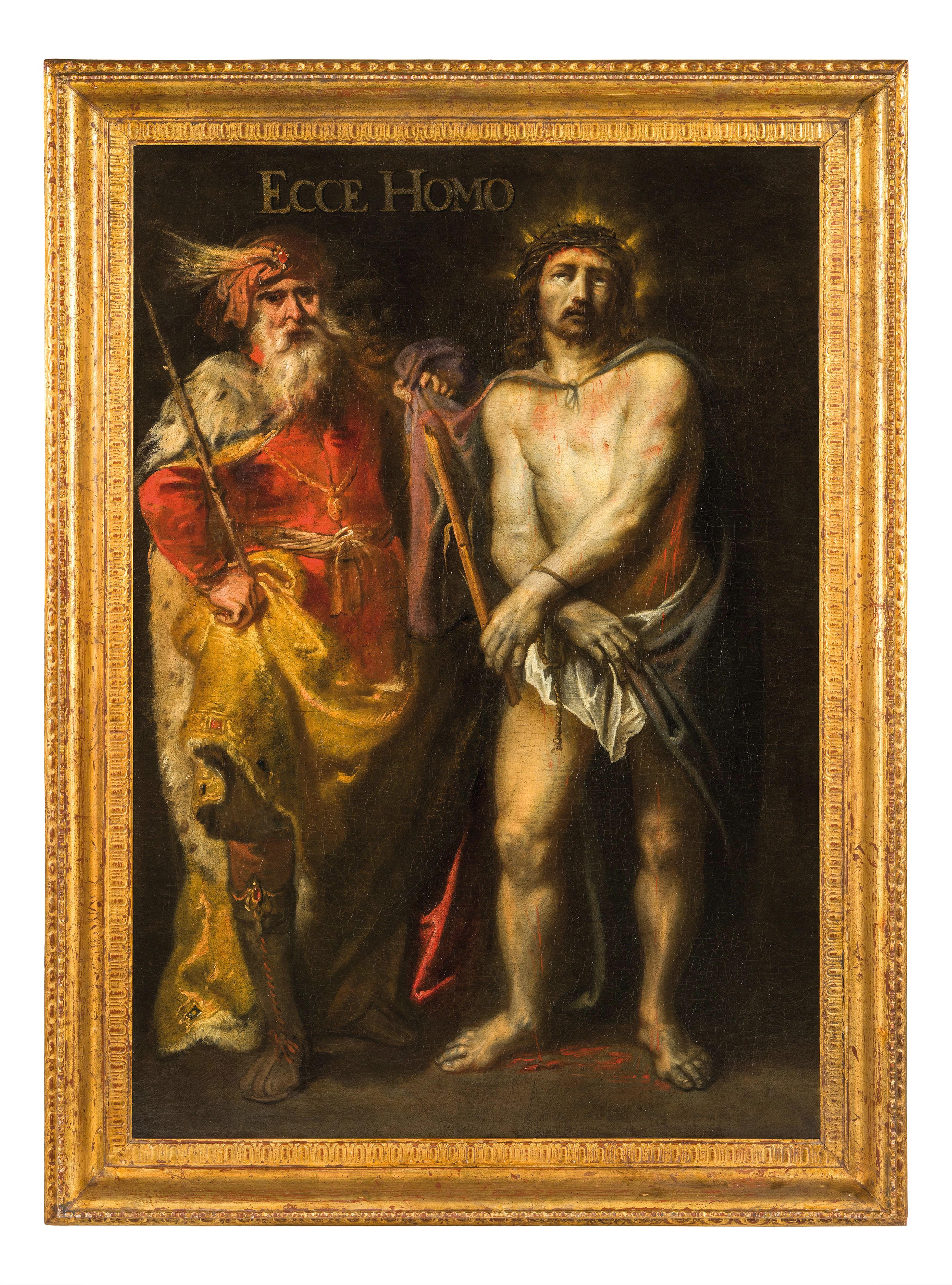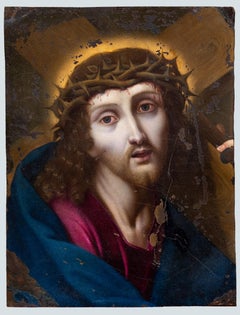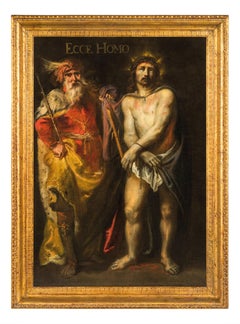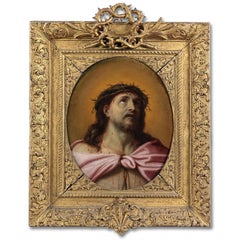Items Similar to Ecce Homo Christ Paint Oil on canvas 17th Century Old master Leonardo Italian
Want more images or videos?
Request additional images or videos from the seller
1 of 15
Ecce Homo Christ Paint Oil on canvas 17th Century Old master Leonardo Italian1630-1699
1630-1699
$5,933.63
$7,417.0320% Off
£4,418.70
£5,523.3720% Off
€4,992
€6,24020% Off
CA$8,192.17
CA$10,240.2120% Off
A$9,082.23
A$11,352.7920% Off
CHF 4,773.07
CHF 5,966.3320% Off
MX$111,151.64
MX$138,939.5520% Off
NOK 59,610.76
NOK 74,513.4620% Off
SEK 55,950.67
SEK 69,938.3320% Off
DKK 38,007.42
DKK 47,509.2820% Off
About the Item
Lombard painter of the seventeenth century
Ecce Homo
Oil painting on canvas
56 x 43 cm. , framed 75 x 63 cm.
Provenance: Florence, Pandolfini, 5.10.2021, lot 209
The proposed canvas, the work of a Lombard painter active in the seventeenth century, shows the image of Christ portrayed according to the iconography of the Ecce Homo, with a crown of thorns placed over his long hair, stripped of his clothes, waiting for the his immediate crucifixion on Golgotha
… Jesus came out, wearing the crown of thorns. Pilate said to them: "Here is the man." Seeing him, the chief priests and the henchmen shouted: "Crucify him, crucify him" (Gospel of John 19.5).
This type of representation of Christ, defined precisely Ecce Homo and which, as specified, takes precedence at the moment of his Crucifixion, after being arrested and scourged, while he is made the object of ridicule by the Roman soldiers, who crown him with thorns as a sign of mockery of the one who had proclaimed himself the King of Kings, spread in the sixteenth century, giving rise to particularly intense creations.
The image reconciles the remarkable spiritual strength of Christ in his moment of human suffering with a refined elegance, supported by the superb descriptive ability of the face that stands out from the dark background.
Although Ecce Homo is not an 'easy' subject, in our case it is not a work treated with a strong dramatic sense, but equally capable of moving. Waiting for his martyrdom, what strikes is his face which appears imperturbable and not at all suffering, but also serene, to evoke the forgiveness that he has granted to his executioners.
The canvas is in good condition, considering the time.
The painting, like all our objects, is sold with a certificate of photographic authenticity in accordance with the law.
For more information please contact us: we are at your complete disposal for any information.
- Attributed to:Lombard painter of the 17th century (1600 - 1699, Italian)
- Creation Year:1630-1699
- Dimensions:Height: 29.53 in (75 cm)Width: 24.81 in (63 cm)
- Medium:
- Movement & Style:
- Period:
- Condition:
- Gallery Location:Riva del Garda, IT
- Reference Number:1stDibs: LU98819710602
About the Seller
4.9
Platinum Seller
Premium sellers with a 4.7+ rating and 24-hour response times
Established in 2017
1stDibs seller since 2018
258 sales on 1stDibs
Typical response time: <1 hour
- ShippingRetrieving quote...Shipping from: Riva del Garda, Italy
- Return Policy
Authenticity Guarantee
In the unlikely event there’s an issue with an item’s authenticity, contact us within 1 year for a full refund. DetailsMoney-Back Guarantee
If your item is not as described, is damaged in transit, or does not arrive, contact us within 7 days for a full refund. Details24-Hour Cancellation
You have a 24-hour grace period in which to reconsider your purchase, with no questions asked.Vetted Professional Sellers
Our world-class sellers must adhere to strict standards for service and quality, maintaining the integrity of our listings.Price-Match Guarantee
If you find that a seller listed the same item for a lower price elsewhere, we’ll match it.Trusted Global Delivery
Our best-in-class carrier network provides specialized shipping options worldwide, including custom delivery.More From This Seller
View AllEcce Homo Castello 17th Century Paint Oil on canvas Old master Genoese school
Located in Riva del Garda, IT
17th-century Genoese School
Workshop of Valerio Castello (Genoa, 1624 - Genoa, 1659)
Ecce homo
Oil on canvas
117 x 99 cm.
In frame 138 x 118 cm.
The Ecce Homo, the subject of our ...
Category
17th Century Old Masters Paintings
Materials
Oil
$14,834 Sale Price
20% Off
Ecce Homo Christ Metsys 16th Century Paint Oil on table Flemish Old master
Located in Riva del Garda, IT
16th-century Flemish master
Circle of Quentin Metsys (Leuven, 1466 - Antwerp, 1530)
Ecce Homo
oil on panel
cm. 34 x 23
with frame 47 x 37 (not contemporary)
An important painting...
Category
16th Century Old Masters Paintings
Materials
Oil
$7,293 Sale Price
20% Off
Ecce Homo Coxie Paint 16/17th Century Paint Oil on table Old master Flemish Art
Located in Riva del Garda, IT
Circle of Michael Coxie (Malines, 1499 - Malines, 1592)
Ecce Homo with Pontius Pilate
Oil on panel
Flemish school 16th-17th century
112 x 81 cm - framed 121 x 90 cm.
The proposed p...
Category
16th Century Old Masters Paintings
Materials
Oil
$8,405 Sale Price
20% Off
Jesus Son Salvi Paint Oil on canvas Old master 17th Century Italian Religious
Located in Riva del Garda, IT
Ancient painting depicting Jesus with the Commissioner's son
(Alternative reading: St. Joseph with the Child, or the 'Paternity')
Giovan Battista Salvi known as "the Sassoferrato" (1609 - 1685) circle / follower
Oil painting on canvas
76 x 59 cm. -With frame in the shape of a small temple, not coeval 99 x 84 cm.
The interesting canvas that we are pleased to offer you recalls the iconographic model of classic paternity, which traditionally sees Saint Joseph holding the sleeping baby Jesus...
Category
17th Century Old Masters Paintings
Materials
Oil
$7,169 Sale Price
20% Off
Christ Cross Religious Van Dyck 17th Century Paint Oil on canvas Old master
By Anthoon van Dyck (Antwerp 1599 - London 1641)
Located in Riva del Garda, IT
Anthoon van Dyck (Antwerp 1599 - London 1641) workshop
Christ Carrying the Cross - 17th century
Oil on canvas (120 x 94 cm - framed 140 x 112 cm).
This remarkable canvas, depic...
Category
17th Century Old Masters Paintings
Materials
Oil
$17,059 Sale Price
20% Off
Christ Angels Pietro Da Cortona Paint Oil on canvas Old master 17th Century Art
Located in Riva del Garda, IT
Christ surrounded by angels in the desert
Circle of Pietro da Cortona, born as Pietro Berrettini (Cortona 1597 - Rome 1669)
Oils on canvas (66 x 50 cm. - in frame 80 x 64 cm.)
The ...
Category
17th Century Old Masters Paintings
Materials
Oil
$8,507 Sale Price
20% Off
You May Also Like
Ecce Homo, after Carlo Dolci (1616–1686)
Located in GB
Ecce Homo is a superb, striking and emotive Old Master in oil on copper after the renowned Italian Baroque artist Carlo Dolci. The "Ecce Homo" shows the figure of Christ before His c...
Category
17th Century Baroque Figurative Paintings
Materials
Copper
Old Master Flemish Oil on Canvas Baroque Painting Jesus Christ Ecce Homo 1630
Located in Portland, OR
An important Old Master oil on canvas painting by the Flemish artist, Jan Cossiers, a follower of the style of Caravaggio (1600-1671).
Born in Antwerp in 1600, Jan Cossiers was a pupil of his father, the painter Antoon Cossiers (died 1646/1647), and also studied under Cornelis de Vos...
Category
17th Century Baroque Figurative Paintings
Materials
Canvas, Oil
Antique Spanish Old Master Oil on Wood Panel, Head Portrait of Christ
Located in Cirencester, Gloucestershire
Artist/ School: 18/19th Century Spanish School
Title :Head study of Christ
Medium: oil painting on wood panel, period gilt framed
panel : 6 x 5 inches
Provenance: private collect...
Category
18th Century Old Masters Figurative Paintings
Materials
Oil
Fine Italian 17th Century Oil on Canvas Head of Jesus Christ Crowned with Thorns
By (circle of) Pierre Mignard
Located in LA, CA
A very fine Italian 17th century oval oil on canvas "Head of Christ Crowned with Thorns" Circle of Pierre Mignard (French, 1612-1695) within...
Category
17th Century Old Masters Figurative Paintings
Materials
Oil, Canvas, Wood
Escuela española (XVIII) - Ecce Homo - Óleo sobre tabla
Located in Sant Celoni, ES
La obra no va firmada
Se presenta enmarcada con un marco de principios del siglo xx en madera tallada
El estado de la obra se puede ver, presenta craquelaciones y faltas de pintura...
Category
Mid-18th Century Old Masters Figurative Paintings
Materials
Oil
Religious Subject Oil on Canvas Italy XVII Century
Located in Milan, IT
Oil painting on canvas. It is a vintage copy of the engraving of the same name made by Annibale Carracci (1560-1609), which had immediate success and gave rise to a series of printed replicas and painted copies. It presents the moment of the Passion in which Christ is crowned with the crown of thorns, the object of torture, the disparaging symbol of his proclamation as King of Kings. The act is performed by two figures, the Roman soldier and the Jew, representing the two people who they took part in Christ's death sentence. The figures, vigorous and sanguine, those of the two tormentors paler and more inert than the victim, create an intertwined composition of bodies, with that of the central Jesus joining the other two, uniting them in the shared responsibility of what they are doing; placed sideways, Jesus has his head bent forcibly to the left by the soldier who imposes the crown of thorns on him, while the Jew on the right places the bamboo cane in his hand, replacing the scepter. The scene is dominated by gloomy and dark colors, among which only the bright red of Christ's robe stands...
Category
17th Century Other Art Style Figurative Paintings
Materials
Oil
More Ways To Browse
Italian 17th Century Frame
17th Century Italian Painting
17th Century Italian Oil Painting
Christ Oil Painting
Oil Painting Of Soldier
John Law
Oil Paintings Of Jesus
Jesus Christ Art
Antique Paintings Of Jesus
Seventeenth Century Paintings
Italian Oil Painting Old Man
Jesus Christ Paintings
Crucifixion Paintings
Italian Lombard
Old Master Christ
17th Century Painting Of Christ
Oil Priests
Roman Soldier Art
